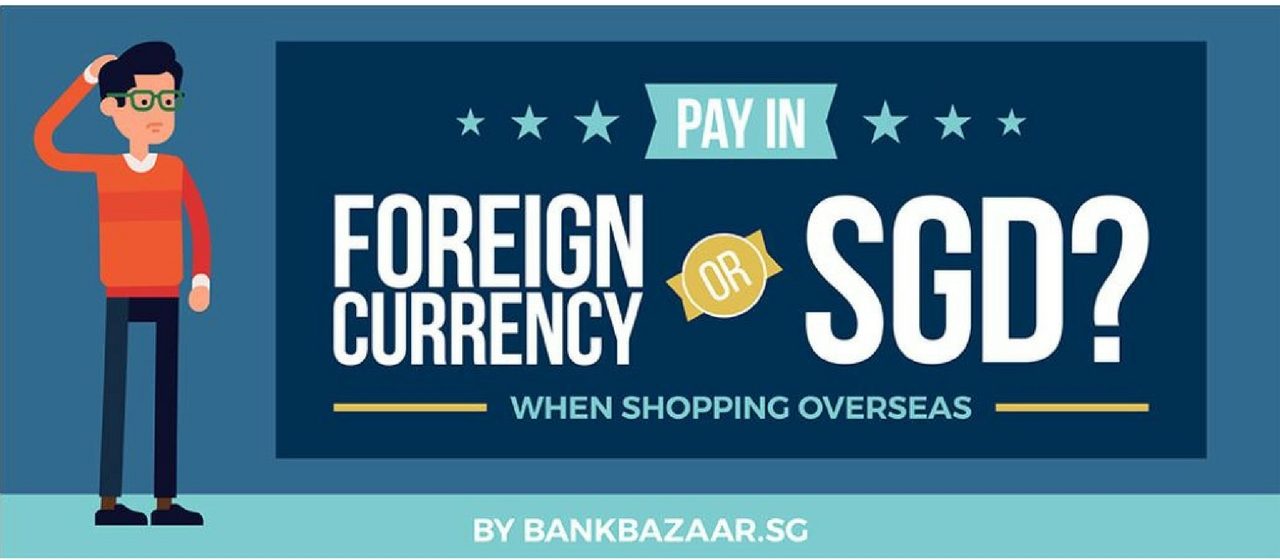Why you should always pay in local currency when shopping with your credit card overseas

When shopping overseas or making purchases from a foreign website, you may be asked which currency you would prefer to pay in – Singapore dollars (SGD) or the country’s local currency (e.g. USD; EUR).
Which do you choose? SGD? Wrong answer. You should always pay in the local currency of the country you are in, or the website you are purchasing from.
Why? The answer is in your credit card’s Terms & Conditions document. We’ve summarised it for you-
SGD or local currency? The answer is always local currency!
Overseas credit card transaction fees
When you’re making a transaction overseas, you have to pay some fees whether or not you make it in SGD or local currency. This may include charges applied by the payment network, bank administration, and/or merchant.
- Transactions in foreign currency
– Bank administrative charges, as well as charges put forth by card associations (such as Visa, Mastercard, American Express). The combined fees from most card issuers in Singapore typically range from 1% to 3%. CIMB Visa Signature and CIMB Platinum Mastercard do not charge admin fees. - Transactions in SGD but processed abroad
– Card association fees (around 1%) and other not-so-transparent potential markups. The potential markups are usually applied at the point of transaction and need to be acknowledged and accepted by you.
Markups mean you don’t save by paying in SGD
Firstly, paying in SGD will not save you from foreign transaction fees applied by your card association. The notion that doing so will save you from foreign transaction fees is nothing but a misconception. Sadly, it isn’t just the foreign transaction fee that you should be worried about.
There is also something known as a Dynamic Currency Conversion (DCC) fee attached to your overseas transactions too, especially if you are using a Mastercard or Visa.
What is Dynamic Currency Conversion (DCC)?
Have you ever noticed that when you are shopping abroad, you sometimes get asked if you’d like to pay in your home currency or the local currency?
If you opt to pay in your home currency, the merchant will convert the local currency amount to SGD on your behalf. That service is called Dynamic Currency Conversion.
Dynamic Currency Conversion sounds attractive because when spending, one has no idea what exchange rates our credit card company uses when converting foreign currency transactions to SGD. So when offered an instant conversion, it sometimes feels more assuring to go with the converted amount.
Unfortunately, the certainty of knowing how much your transaction will cost in your home currency does not come cheap. For providing the DCC services, merchants will layer on a markup on the currency exchange rate, sometimes going as high as 5% or more.
Remember, opting to pay in SGD does not save you on the foreign transaction fee. Your credit card issuer will still charge the admin fees (around 1%) on the foreign transaction in addition to the DCC markup that you paid to the merchant. In order to save, the DCC markup needs to be less than 2% at least, which is rather unlikely.
How can you avoid incurring unnecessary DCC charges?
Here are a few suggestions:
Always opt to pay with the local currency (the currency of the country you are in) instead of SGD (your home currency).
If the merchant insists that you pay in SGD, ask for the transaction to be voided and consider shopping elsewhere.
Write ‘DCC rejected’ on the credit card charge slip on both copies – the merchant copy as well as yours. This will help your case if you choose to raise a dispute.
In short, when using a credit card for your purchases abroad, do not pay in SGD. It is usually costlier as compared to paying in local currency with your credit card.

Source: BankBazaar.sg

Leave a Reply
Want to join the discussion?Feel free to contribute!